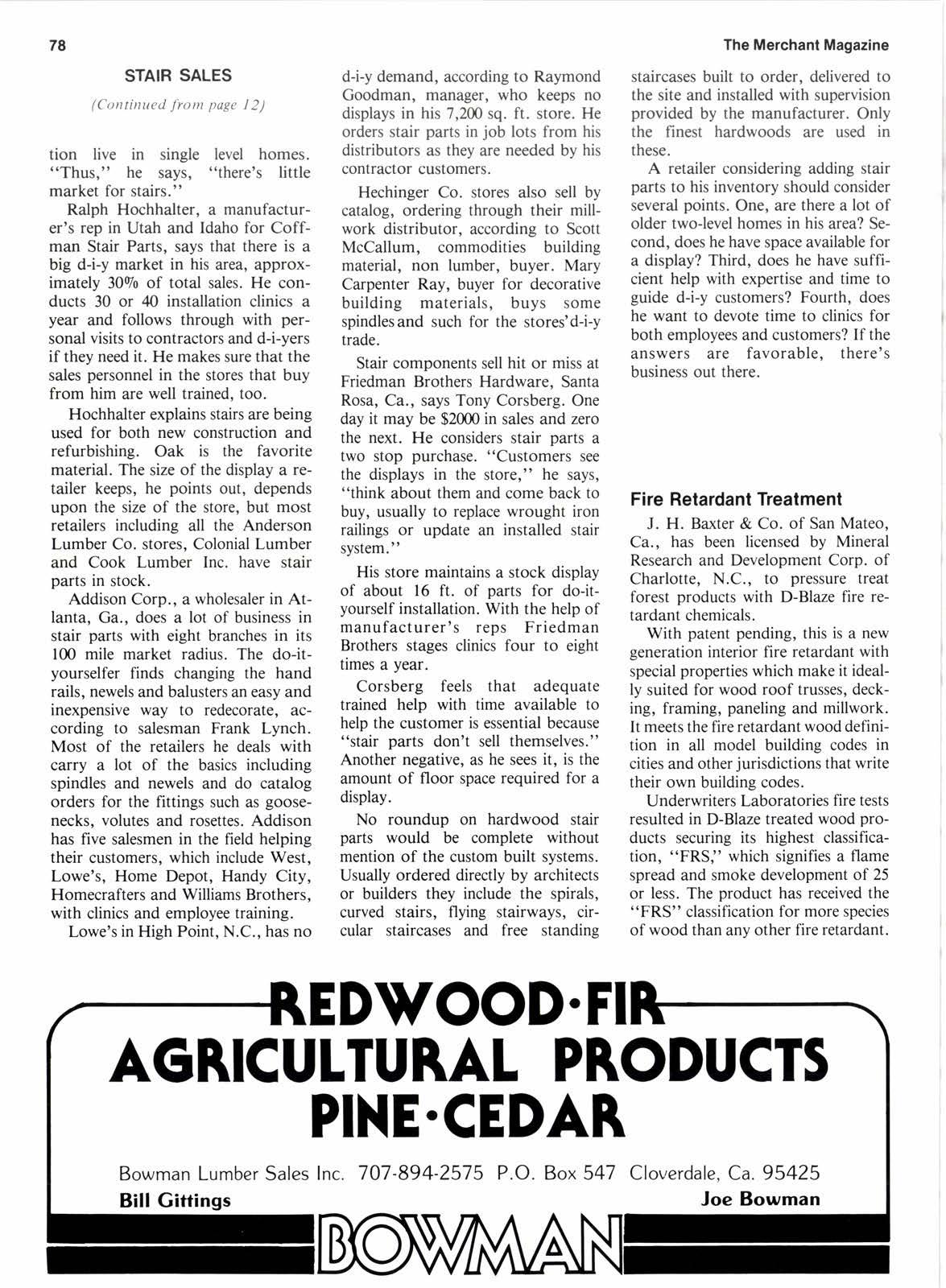
3 minute read
STATR SALES
(Continued from page I2) tion live in single level homes. "Thus," he says, "there's little market for stairs."
Ralph Hochhalter, a manufacturer's rep in Utah and Idaho for Coffman Stair Parts, says that there is a big d-i-y market in his area, approximately 3090 of total sales. He conducts 30 or 4O installation clinics a year and follows through with personal visits to contractors and d-i-yers if they need it. He makes sure that the sales personnel in the stores that buy from him are well trained, too.
Hochhalter explains stairs are being used for both new construction and refurbishing. Oak is the favorite material. The size of the display a retailer keeps, he points out, depends upon the size of the store, but most retailers including all the Anderson Lumber Co. stores, Colonial Lumber and Cook Lumber Inc. have stair parts in stock.
Addison Corp., a wholesaler in AtIanta, Ga., does a lot of business in stair parts with eight branches in its 100 mile market radius. The do-ityourselfer finds changing the hand rails, newels and balusters an easy and inexpensive way to redecorate, according to salesman Frank Lynch. Most of the retailers he deals with carry alot of the basics including spindles and newels and do catalog orders for the fittings such as goosenecks, volutes and rosettes. Addison has five salesmen in the field helping their customers, which include West, Lowe's, Home Depot, Handy City, Homecrafters and Williams Brothers. with clinics and employee training.
Lowe's in High Point, N.C., has no d-i-y demand, according to Raymond Goodman, manager, who keeps no displays in his 7,200 sq. ft. store. He orders stair parts in job lots from his distributors as they are needed by his contractor customers.
Hechinger Co. stores also sell by catalog, ordering through their millwork distributor, according to Scott McCallum, commodities building material, non lumber, buyer. Mary Carpenter Ray, buyer for decorative building materials, buys some spindlesand such for the stores'd-i-y trade.
Stair components sell hit or miss at Friedman Brothers Hardware, Santa Rosa, Ca., says Tony Corsberg. One day it may be $2000 in sales and zero the next. He considers stair parts a two stop purchase. "Customers see the displays in the store," he says, "think about them and come back to buy, usually to replace wrought iron railings or update an installed stair system. "
His store maintains a stock display of about 16 ft. of parts for do-ityourself installation. With the help of manufacturer's reps Friedman Brothers stages clinics four to eight times a year.
Corsberg feels that adequate trained help with time available to help the customer is essential because "stair parts don't sell themselves." Another negative, as he sees it, is the amount of floor space required for a display.
No roundup on hardwood stair parts would be complete without mention of the custom built systems. Usually ordered directly by architects or builders they include the spirals, curved stairs, flying stairways, circular staircases and free standine staircases built to order, delivered to the site and installed with supervision provided by the manufacturer. Only the finest hardwoods are used in these.
A retailer considering adding stair parts to his inventory should consider several points. One, are there a lot of older two-level homes in his area? Second, does he have space available for a display? Third, does he have sufficient help with expertise and time to guide d-i-y customers? Fourth, does he want to devote time to clinics for both employees and customers? If the answers are favorable. there's business out there.
Fire Retardant Treatment
J. H. Baxter & Co. of San Mateo, Ca., has been licensed by Mineral Research and Development Corp. of Charlotte, N.C., to pressure treat forest products with D-Blaze fire retardant chemicals.
With patent pending, this is a new generation interior fire retardant with special properties which make it ideally suited for wood roof trusses, decking, framing, paneling and millwork. It meets the fire retardant wood definition in all model building codes in cities and other jurisdictions that write their own building codes.
Underwriters Laboratories fire tests resulted in D-Blaze treated wood products securing its highest classification, "FRS," which signifies a flame spread and smoke development of 25 or less. The product has received the "FRS" classification for more species of wood than any other fire retardant.










